Exploring Shopping Centers' Impact on Dubai
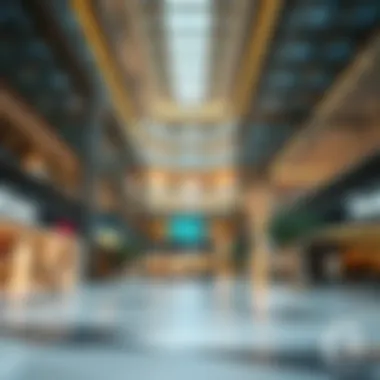
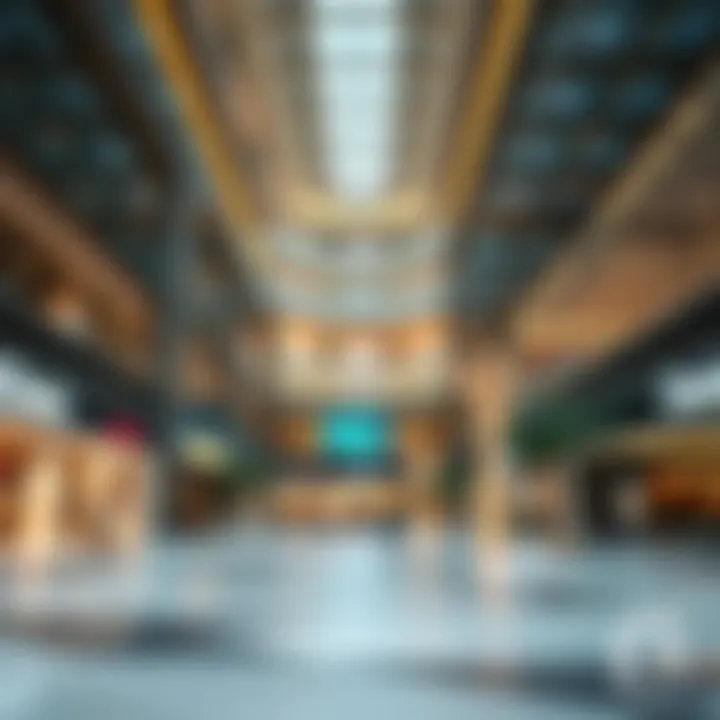
Intro
The shopping landscape in Dubai evolves continuously, echoing the city's rapid growth and economic ambition. As the world flocks to this vibrant metropolis, shopping centers, or محلات مكاني مول, stand as pivotal players in its urban development narrative. These establishments do more than just offer goods and services; they shape consumer experiences and alter the social fabric of communities.
Potential investors, property developers, and consumers are drawn to the allure of these modern shopping spaces. Understanding the nuances of these centers is essential for anyone looking to navigate the complex Dubai real estate market.
In this article, we delve into various dimensions of shopping centers in Dubai, focusing on their architectural styles, tenant mix, consumer behavior, and investment potential. Each section aims to enhance your insight into how these centers operate and their profound impact on the economy.
Let's embark on this journey through the multifaceted world of Dubai's shopping centers.
The Concept of Shopping Centers
Shopping centers play a pivotal role in the social and economic landscape of modern cities, particularly in a vibrant and diverse metropolis like Dubai. These hubs are not just places to shop; they serve as cultural melting pots, social gathering spots, and key contributors to the urban economy. In the context of this article, understanding shopping centers means exploring their structures, varieties, and implications on city life.
Definition and Characteristics
Shopping centers, generally defined, are commercial establishments that house a variety of retail outlets along with services both for shopping and leisure activities. Characteristically, they provide a space where consumers can access multiple retailers in a single location, often creating an easy and convenient shopping experience. The design and layout of these centers are thoughtfully crafted, often intending to engage visitors through strategic placement of stores, eateries, and entertainment venues.
A defining aspect of shopping centers in Dubai is their blend of luxury and accessibility. With towering architectural designs that are almost a landmark in themselves, these centers integrate high-end brands with more accessible retail options, catering to a diverse demographic.
Types of Shopping Centers
Different types of shopping centers serve various roles within the community, each with distinct characteristics that contribute to their overall function and appeal.
Neighborhood Centers
Neighborhood centers are typically small-scale retail outlets that cater to the daily needs of local residents. They usually include grocery stores, pharmacies, and other essential services. One key characteristic of these centers is their close proximity to residential areas, making them a convenient choice for shoppers looking for quick, everyday items.
A unique feature of neighborhood centers is their ability to foster community interaction. Local events, farmer's markets, and family-friendly activities often take place in these spaces, encouraging a sense of belonging among residents.
While neighborhood centers have their advantages, they may lack the variety of larger shopping options, which can limit the overall shopping experience. However, their convenience often outweighs these drawbacks.
Community Centers
Community centers offer a bit more than neighborhood centers, often incorporating a broader mix of retail and service providers. These centers typically feature specialty shops, fitness facilities, and dining options, catering to families and larger community groups. Their key characteristic is enhanced variety in shopping and services compared to smaller centers.
A unique aspect of community centers is their role in promoting social cohesion. They provide gathering spaces for community activities, workshops, and classes, allowing locals to engage with one another beyond mere transactions.
Despite their advantages, community centers can become quite crowded during peak times, which may deter some shoppers seeking a more peaceful shopping experience.
Regional Malls
Next in scale are regional malls, which serve as significant retail destinations for a broader area. These centers feature a diverse array of national and international brands, making them appealing to a wider audience. The defining feature of regional malls is their size, often including upscale department stores and a variety of entertainment options such as cinemas and amusement zones.
Regional malls contribute greatly to the local economy, drawing in shoppers from neighboring areas. They create jobs and increase foot traffic not just within their own stores, but also for adjacent businesses as people come to shop and then dine or visit other local attractions. One downside is that their size may overwhelm some visitors, potentially leading to a less personalized shopping experience.
Super Regional Malls
Super regional malls take the concept a step further, boasting vast floor spaces and a considerable number of retailers. These shopping centers resemble small cities, often featuring anchor stores that are department giants. They not only provide shopping but also offer leisure activities, family entertainment, and sometimes even cultural experiences.
The primary strength of super regional malls lies in their ability to create a one-stop destination for people seeking a complete day out. Events, seasonal attractions, and special promotions often draw in large crowds. However, like regional malls, their size can be a double-edged sword, as they risk feeling impersonal, removing some of the charm of smaller, more localized shopping venues.
In summary, the concept of shopping centers is multifaceted, reflecting the diverse needs of customers in Dubai’s rapidly evolving urban setting. Understanding these various types can offer deeper insights into their functions, advantages, and limitations in the fabric of daily life.
Cultural Significance in Dubai
Shopping centers in Dubai are more than just places to buy goods; they are dynamic hubs where culture, identity, and social interaction intertwine. In this vibrant city, shopping malls function as cultural landmarks, reflecting the intricate mosaic of its residents. As they facilitate the meeting of diverse communities, these centers often echo the broader narrative of Dubai as a global melting pot of traditions and ideas.
Representation of Diversity
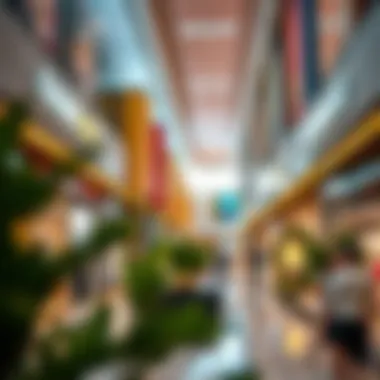
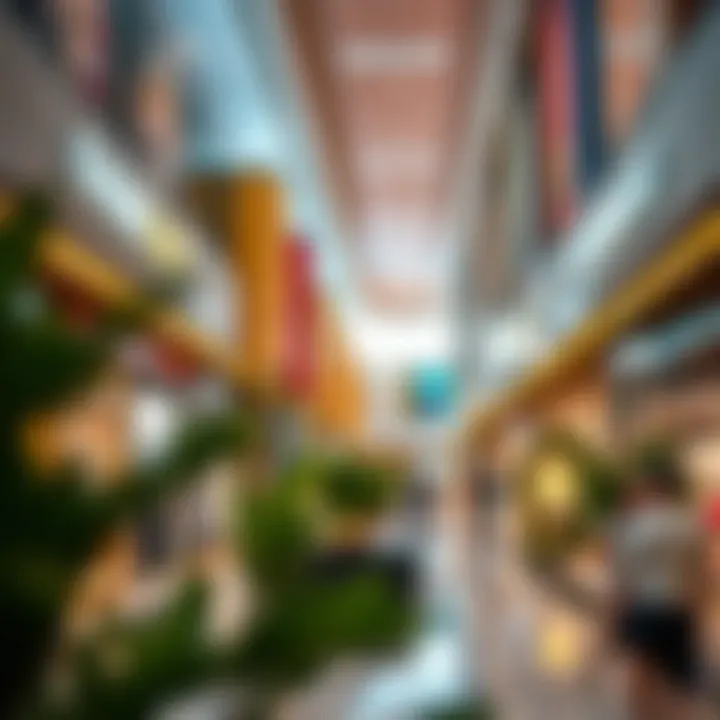
Dubai’s shopping centers act as microcosms of the city’s diversity. From high-end luxury brands to local markets, the array of stores mirrors the multicultural fabric of the UAE. You might stroll through a mall and hear six different languages being spoken in a single conversation, illustrating how this city attracts people from all walks of life.
The architecture and design of these centers also celebrate cultural variety. Breathtaking structures, such as the Dubai Mall, boast styles ranging from contemporary elegance to traditional Arabian motifs. It’s not uncommon to find art installations that draw from local heritage, giving visitors a taste of the city’s history and stories. Additionally, cultural events are frequently hosted in malls, showcasing local artists, performers, and cuisines. This not only entertains but fosters a sense of belonging among differing demographics.
Social Interaction Spaces
Beyond shopping and dining, these malls play an essential role as social interaction spaces. Families, friends, and tourists gather in these centers, making them synonymous with community life. They often serve as effective meeting points. Whether it’s meeting friends for coffee at a stylish cafe or sharing a meal at one of the diverse food courts, the bonding that occurs here is invaluable.
The design of the mall itself encourages engagement. Open spaces, vibrant decorations, and family-friendly activities mean that you can find both lively discussions and quiet corners within the same vicinity. Moreover, events such as festivals, art exhibitions, and live performances provide opportunities for people to mingle and create shared experiences.
Shopping centers also play a crucial role in building community ties. Many host events during Ramadan, Eid, and National Day, promoting solidarity among residents and visitors alike. These gatherings allow people to connect beyond their daily routines, fostering empathy and understanding in a city known for its transient lifestyle.
"Shopping centers in Dubai encapsulate the spirit of community and the celebration of diversity that characterizes life in this dynamic metropolis."
Impact on Urban Development
Shopping centers play a pivotal role in the urban landscape of Dubai, affecting everything from traffic patterns to social interactions within communities. The significance of shopping centers goes beyond mere retail spaces; they are tightly woven into the fabric of urban planning and development, acting as both catalysts and integrators in shaping city dynamics. They create hubs where shopping, dining, and entertainment converge, thus attracting a diverse demographic, including tourists and residents alike.
Integration into City Planning
When it comes to integrating shopping centers into city planning, a multi-faceted approach is essential. Firstly, these centers need to be situated in areas with high foot traffic. Places near public transportation, residential zones, and workplaces are prime real estate for successful shopping centers. For instance, the Dubai Mall isn't just a shopping destination; it's strategically located near key transport links, making it accessible to millions.
Moreover, shopping centers contribute to the urban aesthetic. Cities like Dubai have embraced modern architecture, evident in edifices like Mall of the Emirates, which is not only about shopping but also serves as an architectural landmark. In city planning, these centers can provide green spaces and communal areas, enriching the urban environment.
Additionally, local authorities often consider the impacts of these commercial spaces on traffic flow and public services. A well-placed shopping center can ease congestion in surrounding areas through improved infrastructure. For instance, the successful integration of the City Walk area has led to enhanced pedestrian pathways and vehicular routes, making shopping convenient for all.
Role in Economic Growth
Shopping centers contribute significantly to economic growth, acting as major employment hubs. They create jobs, not only within retail but also in related sectors such as logistics, marketing, and even facilities management. The ripple effect of employment generation is substantial; many families depend on these jobs, which circulate income back into the local community.
Furthermore, these centers often attract international brands, driving consumer spending. Iconic outlets bring in foot traffic and boost tourism, enhancing Dubai's economy. With the rise of luxury retail in shopping centers, the city has not just become a shopping destination but a global commerce center. This phenomenon showcases how shopping centers fulfill economic roles while fostering a unique cultural identity.
The shopping center is not just a place to shop; it's a vital element in the DNA of urban evolution.
In summary, the impact of shopping centers on urban development in Dubai is multifaceted. These spaces foster economic growth, facilitate urban planning, and reflect the cultural dynamism of the city. By understanding their role and integration into city dynamics, one can appreciate how they are not just commercial spaces but crucial elements of urban life.
Architectural Trends
In the bustling environment of Dubai, architectural trends in shopping centers showcase not just aesthetic considerations but also cultural and practical implications. With the city evolving rapidly, the designs emerge as manifestations of innovation and modernity, playing a pivotal role in shaping the interactions between retailers, consumers, and their environments. In a city that prides itself on its skyline and landmarks, these structures have become more than mere shopping venues; they stand as symbols of what Dubai represents on the global stage.
Innovative Design Features
Shopping centers in Dubai aren't confined to traditional layouts or conventional designs. Instead, they serve as showcases for innovative features that entice visitors and encourage engagement. The integration of technology into architecture is notable, with many shopping centers adopting smart systems that enhance user experience. For example, interactive kiosks provide personalized information, while mobile apps facilitate smooth navigation throughout the vast spaces. Moreover, many centers adopt open-air designs, allowing natural light to flood the shopping spaces and diminish energy costs.
Consider the Mall of the Emirates; it has a ski slope that stands in stark contrast to the arid landscape surrounding it, offering customers a unique experience. This creative juxtaposition highlights Dubai’s approach to providing novel experiences while marrying them with retail options. The incorporation of art installations or even interactive elements, like augmented reality, fosters an engaging environment where visitors can spend hours without feeling rushed.
Benefits of Innovative Designs:
- Enhanced Visitor Engagement: Features like thematic decor and innovative layouts nurture exploration.
- Increased Foot Traffic: Unique offerings attract not only shoppers but also tourists, broadenening the audience base.
- Eco-friendly Practices: Many new designs focus on green architecture, incorporating materials that are efficient and sustainable.
Sustainability in Design
In an era where environmental consciousness is paramount, the role of sustainability in the architecture of shopping centers cannot be overstated. Dubai’s shopping centers are increasingly implementing eco-friendly practices, from construction methods to operational policies. This shift not only addresses environmental concerns but can also be economically advantageous in the long run.
Buildings like The Dubai Mall showcase efforts toward sustainability with features such as energy-efficient systems and water-saving technologies. For instance, its design efficiently harnesses resources, employing advanced cooling systems to minimize energy consumption. This focus on sustainability sets a precedent within the region, encouraging other developers to adopt similar practices.
Key Considerations for Sustainable Architecture:
- Resource Efficiency: Utilization of sustainable materials and energy-efficient systems
- Water Management: Systems to recycle and conserve water, critical in a desert environment
- Local Ecosystems: Designs that integrate with and protect local flora and fauna
"In the long run, sustainability not only benefits the planet but it creates a brand identity that resonates with a more eco-conscious consumer base."

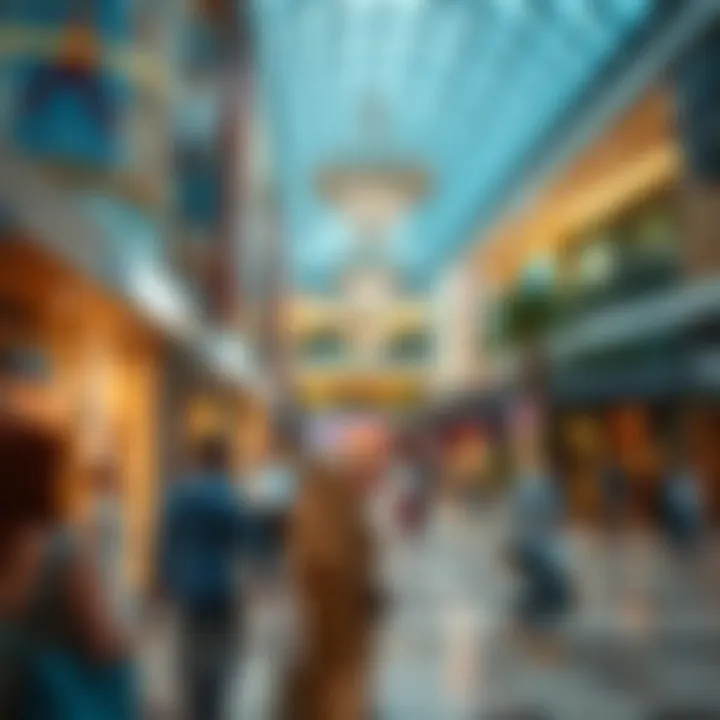
By interlacing the principles of sustainability and innovative design, shopping centers in Dubai position themselves not just as commercial entities but also as proactive members of the urban landscape. As demands shift, architects and developers need to adapt to create spaces that harmonize functionality, aesthetics, and responsible practices. This dynamic approach ensures that the shopping centers remain relevant and pivotal in the landscape of Dubai for years to come.
For further insights into architectural trends and sustainability in urban centers, consider reviewing resources from Wikipedia, Britannica, or the U.S. Green Building Council, which provide comprehensive information on these evolving topics.
Tenant Diversity
Tenant diversity plays a pivotal role in shaping the shopping center environment in Dubai. It not only enhances consumer experience but also drives foot traffic and community engagement. The melding of various retail brands, dining options, and entertainment avenues creates an inclusive atmosphere that caters to a wide spectrum of preferences. For investors and developers, understanding tenant diversity is essential in cultivating a successful shopping ecosystem.
In today's marketplace, consumers seek more than just products—they expect a holistic experience. A shopping center that hosts a rich tapestry of tenants can effectively address this expectation. The presence of globally recognized retail brands alongside niche, local boutiques offers visitors an extensive range of products, making the shopping journey more enticing. This blend is not merely a strategy but a vital component that resonates with the multicultural fabric of Dubai.
Retail Brands Representation
When it comes to retail brand representation, Dubai stands as a microcosm of global trends. Major international brands like Gucci, Chanel, and Apple have established flagship stores in shopping centers like The Dubai Mall, which is a significant draw for both local and international shoppers. However, alongside these luxury labels, there’s a distinct emphasis on fostering home-grown brands. Shops like Kulture House and The Toy Room inject local flavor, ensuring that the centers resonate with the city’s entrepreneurial spirit.
This dual approach is advantageous. International brands bring prestige, while local brands foster community connections. These centers capitalize on the appeal of having a diverse selection that draws varied demographics, enhancing customer retention and satisfaction.
Food and Beverage Outlets
Food and beverage outlets are no longer mere afterthoughts in shopping centers; they have become anchor attractions in their own right. Visitors are increasingly looking for experiences that blend shopping with quality dining. High-end establishments like Palo Verde offer fine dining options, while fast-casual spots like Shake Shack cater to the on-the-go shopper. The juxtaposition of diverse culinary choices, from traditional Emirati fare to global cuisines, creates a food culture within shopping centers that invites patrons to linger.
Research shows that shopping centers with well-curated dining options see an increase in dwell time, ultimately leading to higher sales across retail sections. This trend supports the notion that food courts have evolved into social hubs, enhancing the overall shopping experience.
Entertainment Options
Entertainment options within shopping centers have diversified significantly, providing more than just retail therapy. Establishments like VR Park at The Dubai Mall and IMG Worlds of Adventure cater to families and thrill-seekers alike. These entertainment facets serve a dual purpose: they keep shoppers engaged for longer and draw in crowds, enhancing foot traffic.
Moreover, shopping centers are incorporating cinemas, arcades, and even art galleries as ways to enhance the experience. This trend reflects a broader shift towards experiential retail, where shopping is seen as more than a transactional activity. Encounters with art, culture, and entertainment create an engaging environment that appeals to a wide range of consumers, from families to young professionals.
"The key to a successful shopping center is creating a place where shopping is just one piece of a larger experience. Where you can shop, eat, and play all in one go."
In summary, tenant diversity within Dubai's shopping centers not only supports a vibrant consumer landscape but also invites continual growth and adaptation. By encompassing a wide range of retail brands, diverse food options, and engaging entertainment, these centers ensure their relevance in a rapidly changing market. For investors and developers, recognizing the importance of tenant diversity is critical to fostering an environment that meets the evolving demands of the modern shopper.
Market Trends
Understanding market trends is essential when it comes to the shopping centers in Dubai. The rapid evolution of these centers reflects changing consumer preferences and economic conditions. By delving into market trends, we can glean insights into what drives consumer satisfaction and investment potential.
Consumer Behavior Changes
Consumer behavior in Dubai's shopping centers is shifting, often dictated by lifestyle changes and technological advancements. Increasingly, shoppers are looking for experiences rather than just products.
- Preference for Experience: Shopping is no longer just about acquiring goods. There's a greater emphasis on creating memorable experiences. From in-store events to interactive displays, shopping centers are ramping up efforts to immerse consumers in the brands.
- Sustainability Consciousness: Today's consumers are savvy and environmentally conscious. They prefer brands that reflect a commitment to sustainability. For instance, brands that engage in eco-friendly practices often attract a bigger share of the marketplace.
- Health and Wellness Focus: Additionally, with the increasing interest in health, food establishments now promote healthy eating options, often opting for organic and locally sourced products. This shift signifies an important change in the types of tenants shopping centers are looking to attract.
Moreover, social media has a profound impact on how consumers decide what and when to purchase. Shoppers are influenced by online reviews, social media promotions, and instant accessibility to information. For example, a consumer might visit a mall after seeing a trending product on Instagram, making social influence a potent marketing tool for shopping centers.
E-commerce Influence
E-commerce has disrupted traditional retail, pushing shopping centers to evolve to remain relevant. This influence is evident throughout Dubai.
- Blending Online and Offline: Many shopping centers are adopting a hybrid model. This includes services like click and collect, where customers order online and pick up their purchases at designated locations in physical stores, merging the convenience of e-commerce with the tactile benefits of shopping in-store.
- Tech-Enabled Experiences: Technological advancements are reshaping the shopping experience. Features such as virtual fitting rooms and interactive kiosks help bridge the gap between physical and online shopping. These innovations not only enhance customer engagement but also help shopping centers maintain their position in the competitive landscape.
- Shift in Retail Strategies: Retailers are rethinking their strategies too. Some are shrinking their physical presence while enhancing their online presence through better service and user experience. This means the shopping centers need to strategize accordingly and offer unique experiences that can't be matched online.
Adaptability is crucial for shopping centers navigating these changing tides. With the right strategies, they can turn potential challenges posed by e-commerce into opportunities for growth and innovation.
"The future of shopping is one that embraces both the vibrancy of physical interaction and the convenience of digital innovation."
In summary, market trends shape Dubai's shopping centers significantly. Adapting to these trends isn't just about survival for investors and developers, but also about leveraging them to maximize consumer satisfaction and long-term growth. Keeping a pulse on these shifts can provide a competitive edge vital for success.
Investment Opportunities
Investing in shopping centers has become a significant topic within Dubai's vibrant real estate scene. As a rapidly growing metropolis, Dubai offers a unique blend of factors that make shopping centers not just retail hubs, but strategic assets for investors. Understanding these investment opportunities can provide invaluable insights into capital appreciation and steady income streams.
Rental Yields and Property Valuation
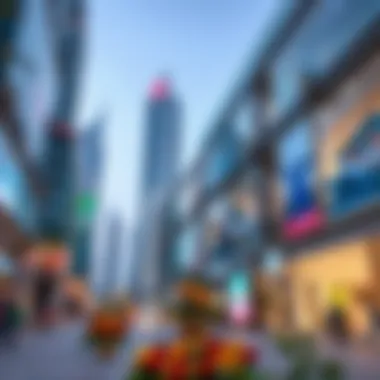
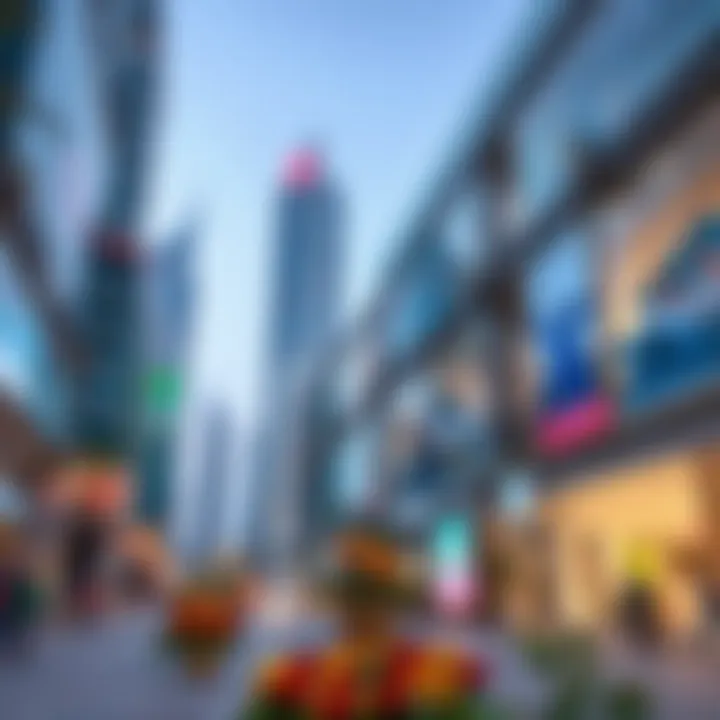
One of the most attractive aspects of shopping center investment lies in the rental yields they offer. Typically, these yields can range from 6% to 10% annually, depending on several factors such as location, tenant mix, and market demand. High-yield areas, like The Dubai Mall or Mall of the Emirates, demonstrate how prime locations can lead to enhanced profitability.
When assessing property valuation, factors like foot traffic, accessibility, and the presence of anchor tenants are critical. The more visitors frequent a shopping center, the higher the demand for retail spaces becomes, leading to increased rents and property values. For instance, a center located near popular tourist attractions may see a spike in both retail clientele and rental income.
In addition, savvy investors keep an eye on market trends. The recent uptick in demand for lifestyle and experience-driven retail spaces signals the need for adaption in property portfolios. If a center can successfully pivot to meet consumer preferences, its valuation can soar.
Future Developments
Looking to the future, the shopping center landscape in Dubai is poised for transformation. Developers increasingly focus on creating mixed-use environments, integrating shopping, dining, and entertainment to create holistic experiences. This trend not only enhances the allure of shopping centers but also attracts diverse investment opportunities.
Connected to this, technological advancements are also shaping future developments. The integration of smart technology, such as interactive kiosks and personalized shopping experiences via mobile applications, can significantly enhance customer satisfaction. This modernization could lead to higher footfalls and subsequently, greater returns for investors.
Moreover, the Dubai government is actively supporting initiatives aimed at boosting tourism through retail. Projects like Dubai Creek Harbour or the upcoming Dubai Square focus on creating mega developments that redefine shopping experiences while providing substantial investment prospects.
In summary, the investment opportunities within Dubai's shopping centers are multi-faceted. With favorable rental yields, strategic property valuation techniques, and exciting future developments, investors can position themselves smartly in a dynamic market. By staying attuned to market shifts and consumer preferences, one can capitalize on the ongoing evolution in Dubai's retail landscape.
"Investing in shopping centers is not just about capturing a piece of real estate; it's about understanding the intricate dance between consumer behavior, economic trends, and urban development."
For further reading and insights on market trends and opportunities in Dubai’s retail sector, resources such as en.wikipedia.org and britannica.com may prove useful.
Challenges Facing Shopping Centers
The landscape of shopping centers is constantly shifting, bringing to light a host of challenges that need to be addressed. As shopping centers have become focal points in urban planning and culture, understanding these challenges is crucial for investors, developers, and stakeholders. This section digs into the economic factors impacting shopping centers in Dubai and the competition they face from online retail.
Economic Factors
Economic fluctuations have a significant sway on shopping centers. In Dubai, the retail environment is currently feeling the effects of several key economic points. Fluctuating oil prices, for example, can lead to varying levels of discretionary spending among residents and tourists, which in turn directly impacts foot traffic in shopping malls. A downturn in oil prices often correlates with a decline in consumer spending, affecting everything from boutique shops to high-end retailers.
Another economic challenge arises from global events like the recent pandemic, which disrupted traditional shopping habits. Consumers became accustomed to online shopping, leading to a decline in physical store visits. In light of this, shopping centers need to adapt quickly, perhaps revising their offerings to include more experiential retail or community-focused spaces.
To navigate these economic challenges, shopping centers in Dubai might consider employing strategic pricing and marketing initiatives. For instance, the introduction of promotional events or seasonal discounts could help boost sales during quieter periods. Additionally, diversifying the types of retailers can mitigate the risk of relying solely on high-end brands, which may not always cater to the broader market.
"It's imperative for shopping centers to recognize and adapt to the shifting sands of economic conditions. Staying ahead of the curve means embracing flexibility and innovation."
Competition from Online Retail
The tide has turned notably toward online retail, creating another layer of challenge for shopping centers. The convenience of shopping at home, especially with the proliferation of mobile apps and e-commerce platforms, has fundamentally altered the retail experience. In this environment, shopping centers must find creative ways to entice consumers to visit their physical locations rather than opting for online alternatives.
Brick-and-mortar stores can no longer rely solely on their name recognition but need to enhance the in-store experience. This could mean integrating technology, such as augmented reality features or interactive kiosks, to engage customers in ways that online shopping cannot. Another strategy might involve collaborating with retailers to create unique product offerings or exclusive in-store promotions that customers cannot replicate online.
Moreover, fostering a community feel where customers can enjoy leisure activities, dining, and social events can make trips to shopping centers more appealing. Malls like The Dubai Mall have set a precedent by not just being a retail destination, but a lifestyle hub. This comprehensive approach is essential to counter online competition effectively and redefine the role of shopping centers in today's market.
The Future of Shopping Centers
The forthcoming landscape of shopping centers is an intricate tapestry woven from consumer expectations, technological advancements, and urban development trends. As Dubai's shopping centers continue to play an instrumental role in reshaping the urban fabric, attention shifts toward understanding how these complex entities will evolve. Anticipating changes in shopping behaviors, environmental considerations, and technological integration is crucial for investors, developers, and businesses alike. The future of these spaces is not just about retail but encompasses a holistic approach incorporating culture, experience, and community engagement.
Evolution and Adaptation
The evolution of shopping centers in Dubai reflects more than just a response to market trends; it showcases an adaptive resilience that is essential in a swiftly changing world. Over the years, shopping centers have transitioned from traditional retail environments to multifaceted hubs catering to diverse needs and desires. Newer centers are increasingly focused on offering a blend of shopping, leisure, and social interaction spaces—transforming the conventional perception of shopping into an experience.
For instance, the emergence of pop-up stores and experiential retail highlights a significant shift in how consumers engage with brands. Traditional long-term leases are being complemented—or sometimes replaced—by short-term agreements that allow businesses to experiment and adapt quickly to market conditions. This flexibility not only benefits retailers but also enhances consumer engagement, making for an enticing environment that keeps shoppers coming back.
Key considerations regarding this evolution include:
- Demographic Changes: A younger, more diverse population demands varied retail experiences.
- Sustainability Concerns: Increasing awareness of environmental issues requires centers to incorporate sustainable practices and eco-friendly designs.
- The Rise of Mixed-Use Developments: Integrating residential, commercial, and recreational spaces within shopping centers creates vibrant communities.
"Understanding the changing consumer landscape is paramount for future success in the retail sector, particularly in a cosmopolitan city like Dubai."
Technological Integration
The role of technology in shaping the future of shopping centers cannot be overstated. From cutting-edge kiosks offering virtual fitting rooms to mobile applications enhancing customer journeys, technology is transforming how shoppers interact with retail spaces. For instance, augmented reality (AR) and virtual reality (VR) provide immersive experiences that can captivate shoppers and enhance their decision-making processes.
Moreover, data analytics plays a significant role in adapting centers to meet evolving consumer needs. By collecting valuable insights about shopping behaviors, preferences, and foot traffic patterns, developers can tailor their offerings with incredible precision.
- Smart Infrastructure: Integration of IoT devices will enable real-time tracking of inventory and customer interactions, leading to improved operational efficiencies.
- Contactless Solutions: The pandemic has accelerated the adoption of contactless payment and shopping options, ensuring a safer experience for consumers.
- Enhanced Customer Experience: Personalization through tailored promotions and location-based services helps centers create meaningful connections with customers.
As the future unfolds, those who invest in technology not just as a tool but as a vital part of the shopping experience will likely lead the charge in setting new standards for shopping centers. Investing in tech-friendly infrastructures allows businesses to stay ahead of trends while enhancing customer loyalty.



